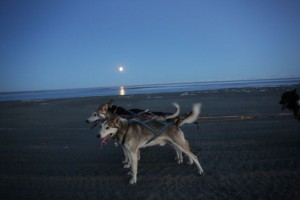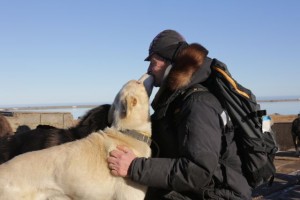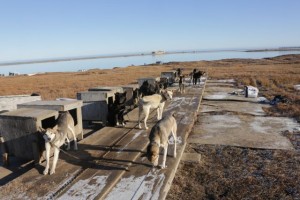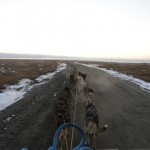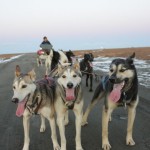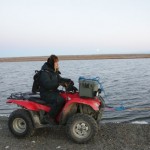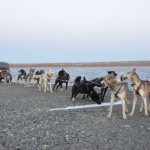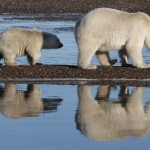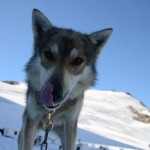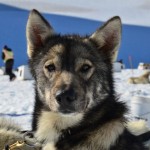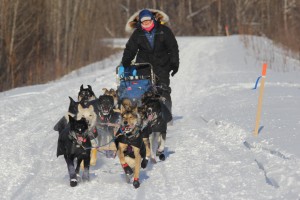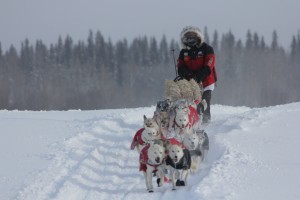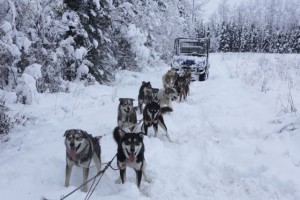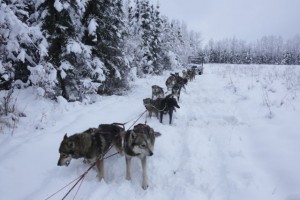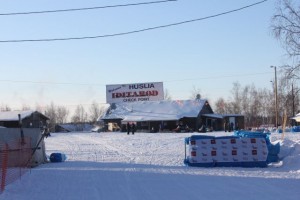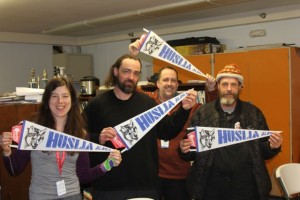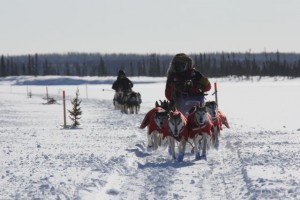Hello Iditarod fans.
Good thing that summer is over, right? October has arrived. That means dog team training time has arrived in earnest for those teams, signed up to compete in Iditarod 44. In some parts of Alaska the end of September has offered some very early snow. Fairbanks has received 2 major snow storms already, the latest one resulting in widespread power outages. Those are only felt by the mushers living on the grid, many do not, specially in the hills north of town. Pictures were circulating on social media, of teams on quads and sleds enjoying the winter wonderland. I met 3 time runner up Aliy Zirkle on our local Two Rivers trails out on a sled with a small dog team, training some patience to young dogs. Our white winter wonderland turned back to slushy mudland for a second time in a row, with temperatures hovering near 40 degrees again. The snow was fun while it lasted.
- Evening run along on Barter Island
- Ketil and dogs
- Muktuk for a snack
- Ketil’s dogs in Kaktovik
Early October also means sign up time for early season mid distance races. The Northern Lights 300, Copper Basin 300 and Knik 200 all filled up quickly. The rush to enter these races is almost a race in itself and race organizers struggle to find a way fair to all. During both the Knik and CB300 signup technology failed during the online procedures. The Copper Basin 300 came up with a nice twist in signups, allowing the Top 10 teams from 2015 to enter early, and then open signup for all other mushers. 7 of those 2015 Top 10 teams took up the chance.
- Running to the west end of Barter
- 3 nice leaders
- Martin Buser having fun
- water break
- Those are out there
- Always looking for food
Something to maybe consider for the future: The limiting factor for the number of allowable dog teams in each race is usually checkpoint parking space, for example fitting 50 teams in the first Checkpoint of Red Eagle Lodge in Chistochina during the CB 300 is a challenge. Mostly the hard core competitive teams really care which starting number they have. Its tough to start in the back, as the trail gets chewed up and also passing is not always easily possible and each pass can eat up quite a bit of time, if it does not go smooth. Yet teams who mostly try to qualify, want to mainly run the race, get 300 miles under their belt and do not care as much about actual finishing times. During the Yukon Quest the Quest 1000 Mile Mushers start a few hours before the Quest 300 mushers, so that in the first checkpoints of Braeburn or Two Rivers respectively teams do not bunch up too much. It might be an idea, to have 2 starting times in popular races like the CB 300 or Knik 200, about 5 or 6 hours apart. After 6 hours most teams have left the first checkpoint. Beyond the first checkpoint run times stretch the race out a lot anyhow and parking is no more issue. Each start time allowing for 40 teams, which in total would get the number up to 80 teams instead of 50 teams . And same as offering the Top 10 of the previous year an early signup, also offering them to be in the first group of 40 starters. It is a very good thing that pre season races are so popular and also to see quite a few new ( new to me ) names in the starting list. Despite rising costs, there seems to be a continued interest to get into the sport.
Looking at the 2016 Iditarod lineup, all Top 10 teams from 2015 are back, with the exception of Aaron Burmeister. His brother Noah is taking the helm of the team this year. While last year 6 teams from Canada started, it is only half of that for 2016 with Jason Campeau for his second run, Michelle Phillips and Rob Cooke being back. Therefore the contingent of Scandinavian Mushers has experienced a strong surge with 6 Norwegians and 1 Swedish team ( Mats Pettersson ). Although Joar Leifseth Ulsom is more or less living in Alaska. Notably Ketil Reitan is back after running his last race in 1994 and concentrating on running dog tours since then. Ketil has strong ties to Kaktovik Alaska and that is where is he currently keeping his dogs. Talk about being remote. Martin Buser and myself had the pleasure of taking Ketils dogs for a run along the beaches of Barter Island. Great dog running and exiting dog running too. Polar Bear tracks are ever present. They do not hibernate. Polar Bears wait for the sea ice to from, so they can leave again, out on the ice, to hunt for seals. Other mushers like Rob Cooke in the Yukon and Jeff King on the Denali Highway have also run into Bear territory. Hopefully those bears will go to sleep soon. 2 Time Iditarod Champion Robert Sorlie is back, after traveling the trail by snowmachine with a large group this year. So is Sigrid Ekran, who has been very successfully racing across the pond in the last few seasons. Iditarod logistics are not easy to begin with, but racing from abroad, specially with own dogs, brings a whole new element to the table, of having to fly the dogs here.
- Jessier Royer 2015
- Dallas Seavey 2015
- Monica Zappa 2015
- Aliy Zirkle 2015
Another thing I always like to look at: Who and how many mushers are doing “ the double “ running the Yukon Quest and Iditarod back to back. Allen Moore is at it again. This has been many years in a row for him doing so. Brent Sass is signed up for both again. He actually fields 2 teams in the Quest, with Meghan Luke running his second string. That could potentially give him a nice team of finishers to pick from, if all goes well…. which on 1000 miles it not always does. Rob Cooke, Cody Strathe are planning to do both, although the Quest has not been kind to Cody lately. New to the double attempt are Scott Janssen who has pulled out of the last 3 Iditarods consecutively and Iditarod Veteran from Norway Tore Albrightsen, who last ran Iditarod in 2006. Running 2 Thousand Mile races in 2 months is a tall order logistically, but also financially. If you would ask the dogs, their response would be: “ Heck ya, bring it on “ , they often just get warmed up after the first 1000 miles.
October also means mushing symposiums are happening, be it in Kiruna Sweden, where Aliy and Allen have travelled to, or in Michigan the Midwest Sled Dog Symposium, where no other than official Iditarod Photographer Jeff Schultz was the keynote speaker, or the Northern New England Sled Dog Trade and Fair, where Jessie Royer, who finished 4th in the 2015 Iditarod, talked about race strategy and training. There is sure a lot to be learned from all of these presenters. Mushing Symposiums are a fun way to kick off the season.
- Looks like winter
- On Two Rivers trails
- Happy to have snow
- Fresh September snow
Much can be written about dog training. There are so many different ways of doing so. Each musher has to work with what ever training situations are possible where they reside and it basically comes down to spending quality time with the dogs. Social media allows glimpses in those different approaches, from mushers having their dogs run on the various glacier operations in Southeast Alaska, to the cart tour operations like Ryan Redington in Skagway, who is back to Iditarod, after a several year hiatus. Happy Trails Kennel from Big Lake who also brings dogs to the glaciers, will field 3 teams with Martin and Rohn Buser as well as Tim Pappas being signed up. Current Champion Dallas Seavey has stayed home and came up with an indoor training facility in a refrigerated trailer. How genius is that, a huge treadmill in 40 degrees temperatures? That sure got some attention, whereas his father Mitch quipped back with his “ just mush “ approach of hooking dogs to a traditional ATV. Jeff King can be seen as usual on the Denali Highway, on early snow. Then again the team members from SP Kennels here in Two Rivers have been doing shorter runs only. Wade Marrs, who finished a personal best 8th place this year can be seen with a long string of dogs on a paved road, commenting ” trying something new this year, stay tuned”. They all do things ” their way “, yet, all of those teams are very high performers come Iditarod 5 month away. They all have one thing in common: They simply love to spend time with their dogs. The next 5 month are crucial in a teams success. 2 months left to the first race of the season, the Alpine Excursion Race on the Denali Highway from Cantwell to Alpine Lodge and back. Let the snow fly and actually stick around too, that would be nice.
Happy trails.
Sebastian
- Huslia 2015
- Happy to be there
- Dallas Seavey catching Thomas Waerner
- Arriving in Huslia




